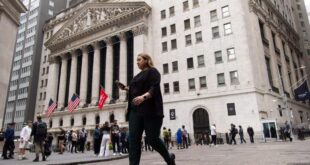Fourteen months. That’s how long financial commentators have been speculating about the day the Federal Reserve will finally start cutting interest rates again.
Deliverance is finally due to arrive on Sept. 18, 2024, when the Fed’s policymaking committee concludes its next meeting. At the moment of climax, the federal funds interest rate is likely to decline from 5.5% to 5.25% and civilization as we know it will be forever changed.
Is it possible to overanalyze the Fed? The Wall Street ecosystem clearly doesn’t think so. Big banks and forecasting firms have issued hundreds, possibly thousands, of reports during the last year attempting to predict exactly what the Fed is likely to do, and when. Stocks rise and fall as the prospect of easier money seems closer, or farther. Every day, financial news anchors ask experts when the Fed is likely to start cutting rates, by how much, and for how long.
The answer is finally at hand. The Fed is all but certain to announce a quarter-point rate cut on Sept. 18, which will be the beginning of a gradual easing cycle that could end with short-term rates at around 3% by 2026. The interest rate guess-casting won’t end after the first rate cut, but once the Fed pivots from tightening to easing, the stakes of future moves won’t be nearly as high.
Read more: What the Fed rate decision means for bank accounts, CDs, loans, and credit cards
Fed rate-cutting has dominated the financial outlook because it captures everything going on in the economy better than any other single metric. It has also factored into the 2024 presidential election since it’s the Fed more than any other body that will finally signal when inflation, the bane of Joe Biden’s presidency, is licked. With the Fed cutting just as the last undecided voters are making up their minds, it could provide a subtle tailwind for Vice President Kamala Harris, who replaced Biden at the top of the Democratic ticket in July.
For two years following the COVID outbreak in 2020, the Fed kept short-term rates at effectively 0%. That was emergency medicine the Fed felt necessary to jolt the economy back to life during the pandemic shock. Among other things, the so-called “zero bound” brought mortgage rates to record lows, fueling a real-estate boom and putting free money in the pockets of millions of homeowners who refinanced at sharply lower rates.
Easy money led to inflation, however, and in March of 2022, with the inflation rate suddenly at an eye-popping 8.5%, the Fed began rapidly raising rates. By July of 2023, when the Fed enacted its final rate hike, short-term rates had gone from 0% to 5.5%.
Drop Rick Newman a note, follow him on X, or sign up for his newsletter.
The next 14 months brought a frenzy of Fedspeak as investors tried to suss out whether the Fed was really done hiking and when it would pivot to easing once again. Fed Chair Jerome Powell reiterated over and over and over and over and over that the Fed is “data dependent” and will cut when the numbers justify doing so. Mostly he was talking about inflation and labor market data.
The numbers have now aligned. The inflation rate peaked at 9% in June 2022 and gradually fell after that. It’s now at 2.5%, close to the Fed’s target of 2%. The only real inflation left is in rent, still running at 5%, and in anomalies such as insurance, which is up for reasons not related to the basic economy.
Read more: Cell phones, furniture, used cars: Here’s where prices are easing up as inflation cooldown continues
The Fed cares about jobs because part of its mission is to “maximize employment” and make sure tight monetary policy doesn’t cool the economy so much that it causes a recession. Job growth is still doing OK, but it has weakened from the blistering growth of 2022 and 2023. The combo of falling inflation and cooling job growth basically gives the Fed the green light to start cutting, at long last.
The Fed itself contributes to incessant Fedspeak by trotting out top policymakers all the time for speeches, interviews, and other public events. A now discontinued database of public remarks by Fed policymakers lists 116 appearances by Powell, et al., during the first eight months of 2023. Assuming that pace continued throughout 2024, it would total nearly 300 sets of remarks from Fed officials since the start of 2023 for analysts and investors to parse and spin.
It didn’t used to be this way. Legendary Fed Chair Alan Greenspan, who led the central bank from 1986 to 2006, was famous for obfuscatory Yoda-like proclamations that left everybody guessing about the Fed’s intentions. His successor, Ben Bernanke, felt the Fed needed to be more transparent, especially amid the Fed’s dramatic and unprecedented efforts to stop the Great Recession in 2008 and 2009 from becoming another depression.
So we now have nonstop analysis from Fed principals and everybody else in the market trying to interpret what they mean. That’s probably a good thing since it reduces the likelihood of surprises. Everybody with a brokerage account knows the Fed is going to cut rates in mid-September because the Fed has basically said so. On the downside, investors these days may put too much effort into scrutinizing every Fed utterance so they can front-run whatever the Fed ends up doing.
All that transparency may be part of the reason consumer confidence has been ticking upward in recent weeks. Longer-term rates, including mortgages, are already coming down in anticipation of looser monetary policy. Potential homebuyers might be thinking they’re about to get a break. The driving force is declining inflation, which in itself cheers consumers.
When President Joe Biden was still running for reelection, one of the biggest questions was whether inflation would improve enough for the Fed to start cutting rates before Election Day, which, in theory, would have given Biden a much-needed boost. After Biden dropped out in July, Vice President Kamala Harris became the potential beneficiary — or victim — of whatever course inflation took, including the Fed pivot.
The timing now favors Harris. A quarter-point rate cut on its own won’t save anybody a ton of money, but a larger, longer-term drop in rates will. And if the Fed is signaling that inflation is over, maybe more voters will start to believe it. The final victory could be a bunch of Fedspeak nobody feels the need to pay much attention to.
Rick Newman is a senior columnist for Yahoo Finance. Follow him on X at @rickjnewman.
Read the latest financial and business news from Yahoo Finance
 meganwoolsey Home
meganwoolsey Home



